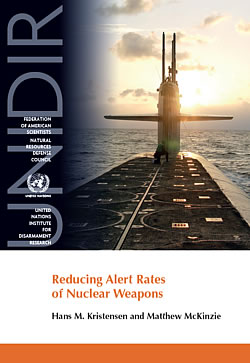Russian Missile Test Creates Confusion and Opposition in Washington
The recent test-launch of a modified Russian ballistic missile has nuclear arms reduction opponents up in arms with claims that Russia is fielding a new missile in violation of arms control agreements and that the United States therefore should not pursue further reductions of nuclear forces.
The fact that the Russian name of the modified missile – Rubezh – sounds a little like rubbish is a coincidence, but it fits some of the complaints pretty well.
Although many of the facts are missing – what the missile is and what the U.S. Intelligence Community has concluded – public information and statements indicate that the missile is a modified RS-24 Yars (SS-27 Mod 2) with intercontinental range.
Whatever the missile is, it is certainly no reason for why the United States should not seek to reduce U.S. and Russian nuclear forces further. On the contrary, the continued modernization of nuclear weapons underscores why it is important that the United States continues its push for reducing the numbers and role of nuclear weapons.
The Accusations
Under the headline “Russian Aggression: Putin violating nuclear missile treaty,” the article on Washington Times Free Beacon web site accuses Russia of being engaged in “a major violation” of the terms of the Intermediate-range Nuclear Forces (INF) Treaty signed with the United States in 1987.
The treaty bans all nuclear ground-launched ballistic and cruise missiles with range between 500 and 5,500 km (about 300-3,400 miles).
Claims of Russian cheating are frequent in the Washington arms control debate – just as claims about U.S. cheating is frequent in the Moscow arms control debate – and the ones in the article are largely consistent with the claims made by Mark Schneider, a former DOD official and now with the National Institute for Public Policy.
The “new” in the article is that it quotes “one official” saying: “The intelligence community believes it’s an intermediate-range missile that [the Russians] have classified as an ICBM because it would violate the INF treaty.” In total, “Two U.S. intelligence officials said the Yars M is not an ICBM,” according to the article.
Two members of Congress, House Armed Services Committee chairman Howard “Buck” McKeon (R-CA) and House Permanent Select Intelligence Committee chairman Mike Rodgers (R-MI), have written President Obama about alleged Russian violations. They complain that they haven’t received a response but the administration says it deals with treaty compliance issue directly with Russia and informs Congress accordingly.
Accusations Disputed
The accusations that the Yars-M is not an ICBM and in violation of the INF Treaty are disputed by Russian officials and, interestingly, previous flight tests of the missile itself.
To its credit, the Washington Times took the trouble of asking Colonel General Victor Yesin about the missile. Yesin is former Chief of Staff of the Russian Strategic Rocket Forces and apparently a consultant to the Chief of the General Staff. But Yesin clearly disputed the claim by the U.S. intelligence officials, saying that the Yars-M is a “Topol-M class ICBM” and that “its range is over 5,500 km.”
That assessment fits the description made by a source in the General Staff in November 2012, following the first Yars-M launch from Kapustin Yar in October 2012 and news media rumors that Russia was developing a “fundamentally new missile.” “There are no fundamentally new missiles ‘on the approach’ for [the Russian Strategic Rocket Forces]. We are talking about modernizing the existing Yars class by improving the warhead,” he told Interfax and explained:
“Take the Layner [modification of the SS-N-23] sea-based intercontinental ballistic missile, reported by some media to be a completely new missile. It is in fact a Sineva. Only the warhead is new. Novelty lies in greater missile defense penetration capabilities, achieved owing to, among other things, a greater number of re-entry vehicles (boyevoy blok) in the warhead. The same applies to the prototype missile that was successfully launched from Kapustin Yar (Astrakhan Region) recently. There is nothing new in the missile itself. Only the ‘head’ is new. Its creators went down the same route as the designers of the Layner.”
Moreover, the claim that the short flight range of the missile test launched from Kaputsin Yar in June 2013 would indicate that the Yars-M is not an ICBM ignores that an earlier flight test of the missile last year flew 5,800 kilometers from Plesetsk north of Moscow to the Kura test range on the Kamchatka Peninsula (see table).
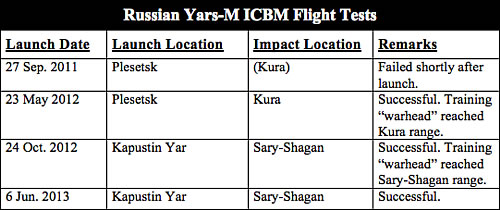
After the May 2012 flight test, Colonel-General Vladimir Zarudnitsky of the General Staff said: “As part of the approved plan of your building the armed forces of the Russian Federation last night made a promising test launch rocket system” Frontier “with an intercontinental ballistic missile high-precision shooting.” (Emphasis added).
Col. Vadim Koval, a Russian defense ministry spokesperson, said “the main goals and tasks of the launch consisted of receiving experimental data on confirming the correctness of the scientific-technical and technological decisions in developing the intercontinental ballistic missile as well as checking the performance and determining the technical characteristics of its systems and components.” (Emphasis added).
Rather than an entirely new missile, Koval explained further, “This missile is being created by using and developing, to the maximum extent, already existing new capacities and technological solutions, which were obtained in the development of fifth generation missile complexes, which substantially reduces the terms and expenditures on its creation.”
After the successful initial launch from Plesetsk, the second test was moved to Kapustin Yar apparently to test the capability of the Yars-M payload to evade ballistic missile defense systems. An industry sources told Interfax that, “The use of new fuel is one of the features of the missile. It reduces boost phase engine operation time. Consequently, the missile’s capabilities to penetrate missile defense will go up.”
It is rare, but not unheard of, that ICBMs are launched from Kapustin Yar into the Sary-Sagan test range. It appears to happen when ICBM payloads are being tested against missile defense systems. In addition to the recent tests of the modified SS-27, an SS-25 was test launched from the site on June 7, 2012. The test flight verified the “extended service life” of the SS-25 and “the latest test of an ICBM combat payload.” During the test “information was received which in future will be used in the interests of developing effective means for overcoming missile defense,” according to the Russian Ministry of Defense.
After the June 2013 test, Deputy Prime Minister Dmitry Rogozin, called the modified SS-27 a “missile defense killer.”
It is not unusual that ballistic missiles with intercontinental range are test-flown in a compressed trajectory with much shorter range. That doesn’t make them less than strategic weapons, however. In March 2006, for example, the U.S. Navy launched a Trident II D5 sea-launched ballistic missile with a range of well over 7,400 kilometer (4,000 miles) in a compressed trajectory of 2,200 kilometers (1,380 miles) – about the same range as the Yars-M test on June 6, 2013. No one has suggested that the Trident II D5 therefore is an INF weapon.
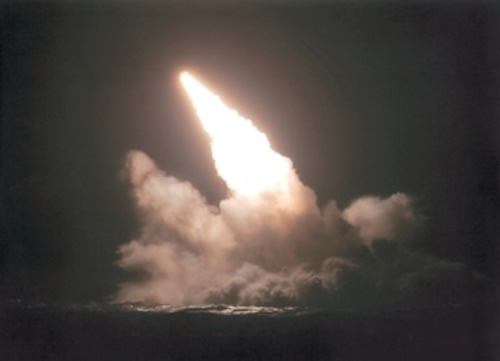
The USS Tennessee (SSBN-734) launches a Trident II D5 SLBM on March 2, 2005, on a compressed trajectory of only 2,200 km – about the same range as the Yars-M test in June 2013.
Conclusions and Recommendations
If there are Russian violations of the INF Treaty, then the United States certainly should raise it directly with Moscow.
But the claim that the Yars-M missile flight-tested on June 6 to a range of 2,050 kilometers is an intermediate-range ballistic missile in violation of the INF treaty seems strange since the same missile apparently was flight tested to an ICBM range of 5,800 kilometers just a year ago.
Of course, we don’t know who the U.S. intelligence officials cited in the Washington Times article are, if what they say is accurate, and to what extent it reflects a coordinated assessment by the U.S. Intelligence Community. We may learn more about the Yars-M in the future.
But several Russian government, military, and industry officials have consistently stated that the Yars-M is not a new missile but a modification of the RS-24 Yars (SS-27 Mod 2) and that it has intercontinental range.
The intension of the allegations in the article seems clear: to create doubts about further reductions of U.S. nuclear forces. One of the “officials” quoted in the article directly questions: “How can President Obama believe [the Russians] are going to live up to any nuclear treaty reductions when he knows they are violating the INF treaty by calling one of their missiles something else?”
The thought that Americans would use INF treaty allegations to argue against reducing the number of strategic nuclear weapons that can hit the United States seems kind of bizarre. After all, under current Russian war plans, many of the 400-500 warheads President Obama has proposed can be offloaded under a new agreement, are most likely currently tasked to hold at risk several hundred targets in the United States – including some in California and Michigan.
Since Russia – unlike the United States – is already below the New START Treaty limit on deployed nuclear weapons and likely to drop further before the treaty enters into force in 2018, it seems like a no-brainer that it is in the U.S. interest to nurture that trend by reducing its own forces further.
This is even more important because the very reason some Russian officials could potentially be tempted to argue that an INF-missile was needed is that China is modernizing of its medium-range missile forces. Ironically, many of those in the United States who make the accusations about Russian INF violations are the same people who also warn about China’s nuclear modernization.
What the article completely seems to miss is that the only way that China and smaller nuclear weapons states may be persuaded to place limits on their nuclear arsenals is if the United States and Russia take bold steps to reduce their still enormous nuclear arsenals. Why then nitpick about dubious INF accusations to block that from happening?
This publication was made possible by grants from the New-Land Foundation and Ploughshares Fund. The statements made and views expressed are solely the responsibility of the author.
Air Force Briefing Shows Nuclear Modernizations But Ignores US and UK Programs
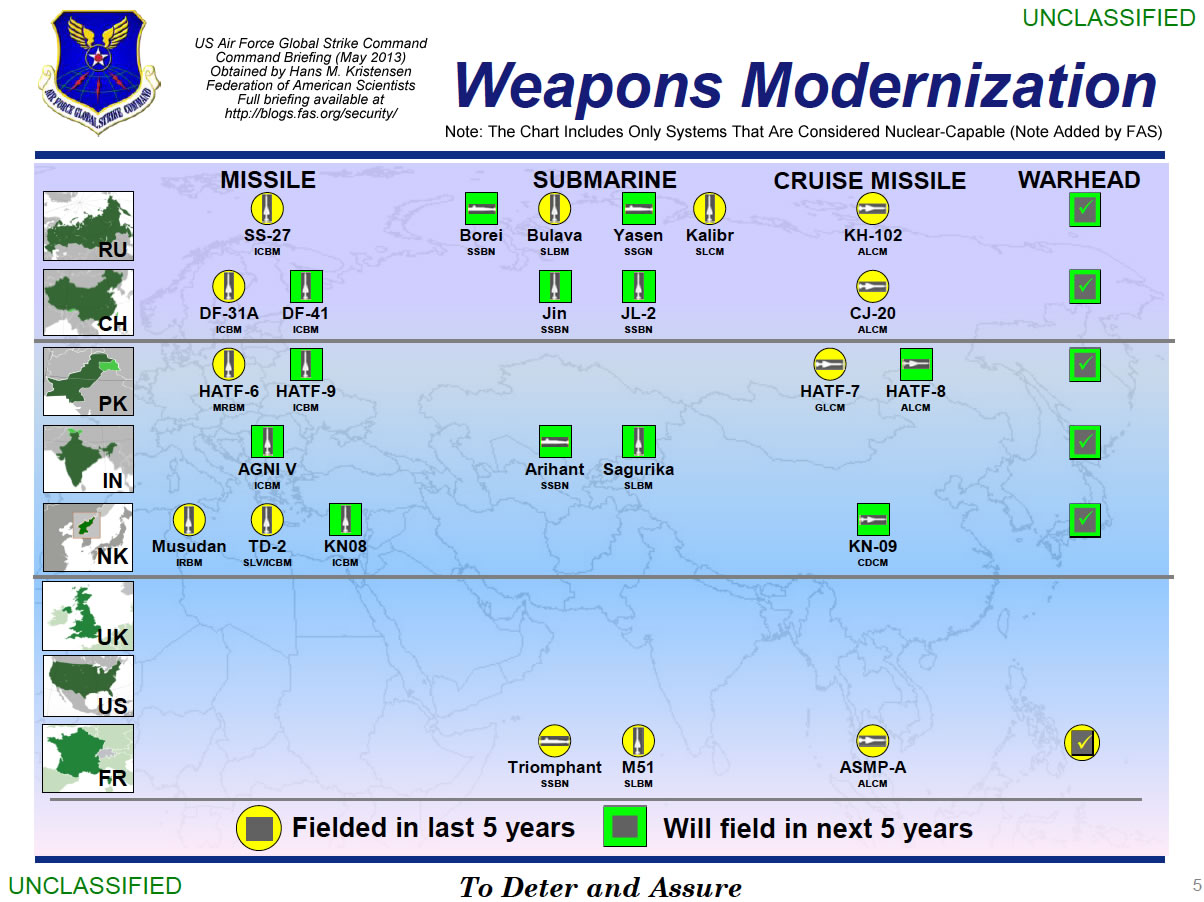
Click to view large version. Full briefing is here.
By Hans M. Kristensen
China and North Korea are developing nuclear-capable cruise missiles, according to U.S. Air Force Global Strike Command (AFGSC).
The new Chinese and North Korean systems appear on a slide in a Command Briefing that shows nuclear modernizations in eight of the world’s nine nuclear weapons states (Israel is not shown).
The Chinese missile is the CJ-20 air-launched cruise missile for delivery by the H-6 bomber. The North Korean missile is the KN-09 coastal-defense cruise missile. These weapons would, if for real, be important additions to the nuclear arsenals in Asia.
At the same time, a closer look at the characterization used for nuclear modernizations in the various countries shows generalizations, inconsistencies and mistakes that raise questions about the quality of the intelligence used for the briefing.
Moreover, the omission from the slide of any U.S. and British modernizations is highly misleading and glosses over past, current, and planned modernizations in those countries.
For some, the briefing is a sales pitch to get Congress to fund new U.S. nuclear weapons.
Overall, however, the rampant nuclear modernizations shown on the slide underscore the urgent need for the international community to increase its pressure on the nuclear weapon states to curtail their nuclear programs. And it calls upon the Obama administration to reenergize its efforts to reduce the numbers and role of nuclear weapons.
Russia
![]()
The briefing lists seven Russian nuclear modernizations, all of which are well known and have been underway for many years. Fielded systems include SS-27 ICBM, Bulava SLBM, Kalibr SLCM, and KH-102 ALCM.
It is puzzling, however, that the briefing lists Bulava SLBM and Kalibr SLCM as fielded when their platforms (Borei SSBN and Yasen SSGN, respectively) are not. The first Borei SSBN officially entered service in January 2013.
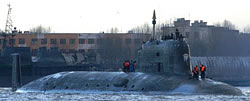
Nuclear Cruise Missile For Yasen SSGN
It is the first time I’ve seen a U.S. government publication stating that the non-strategic Kalibr land-attack SLCM is nuclear (in public the Kalibr is sometimes called Caliber). The first Yasen SSGN, the Severodvinsk, test launched the Kalibr in November 2012. The weapon will also be deployed on the Akula-class SSGN. The Kalibr SLCM, which is dual-capable, will probably replace the aging SS-N-21, which is not. There are no other Russian non-strategic nuclear systems listed in the AFGSC briefing.
A new warhead is expected within the next five years, but since no new missile is listed the warhead must be for one of the existing weapons.
China
![]()
The briefing lists six Chinese nuclear modernizations: DF-31A ICBM, DF-41 ICBM, Jin SSBN, JL-2 SLBM, CJ-20 ALCM, and a new warhead.
The biggest surprise is the CJ-20 ALCM, which is the first time I have ever seen an official U.S. publication crediting a Chinese air-launched cruise missile with nuclear capability. The latest annual DOD report on Chinese military modernization does not do so.
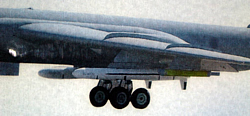
H-6 with CJ-20. Credit: Chinese Internet.
The CJ-20 is thought to be an air-launched version of the 1,500+ kilometer ground-launched CJ-10 (DH-10), which the Air Force in 2009 reported as “conventional or nuclear” (the AFGSC briefing does not list the CJ-10). The CJ-20 apparently is being developed for delivery by a modified version of the H-6 medium-range bomber (H-6K and/or H-6M) with increased range. DOD asserts that the H-6 using the CJ-20 ALCM in a land-attack mission would be able to target facilities all over Asia and Russia (east of the Urals) as well as Guam – that is, if it can slip through air defenses.
The elusive DF-41 ICBM is mentioned by name as expected within the next five years. References to a missile known as DF-41 has been seen on and off for the past two decades, but disappeared when the DF-31A appeared instead. The latest DOD report does not mention the DF-41 but states that, “China may also be developing a new road-mobile ICBM, possibly capable of carrying a multiple independently targetable reentry vehicle (MIRV).” (Emphasis added).
AFGSC also predicts that China will field a new nuclear warhead within the next five years. MIRV would probably require a new and smaller warhead but it could potentially also refer to the payload for the JL-2.
Pakistan
![]()
Pakistan is listed with five nuclear modernizations, all of which are well known: Hatf-8 (Shaheen II) MRBM, Hatf-9 (NASR) SRBM, Hatf-7 (Babur) GLCM, Hatf-8 (Ra’ad) ALCM, and a new warhead. Two of them (Hatf-8 and Hatf-7) are listed as fielded.
The briefing mistakenly identifies the Hatf-9 as an ICBM instead of what it actually is: a short-range (60 km) ballistic missile.
The new warhead might be for the Hatf-9.
India
![]()
India is listed with four nuclear modernizations, all of which are well known: Agni V ICBM, Arihant SSBN, “Sagurika” SLBM, and a new warhead. The U.S. Intelligence Community normally refers to “Sagurika” as Sagarika, which is known as K-15 in India.
Neither the Agni III nor Agni IV are listed in the briefing, which might indicate, if correct, that the two systems, both of which were test launched in 2012, are in fact technology development programs intended to develop the technology to field the Agni V.
The U.S. Intelligence Community asserts that the Agni V will be capable of carrying multiple warheads, as recently stated by an India defense industry official – a dangerous development that could well motivate China to deploy multiple warheads on some of its missiles and trigger a new round of nuclear competition between India and China.
The new warhead might be for the SLBM and/or for Agni V.
North Korea
![]()
North Korea is listed with five nuclear modernizations: Musudan IRBM, TD-2 SLV/ICBM, KN-08 ICBM, KN-09 CDCM, and a warhead.
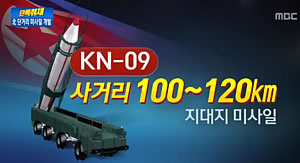
The biggest surprise is that AFGSC asserts that the KN-09 is nuclear-capable. There are few public reports about this weapon, but the South Korean television station MBC reported in April that it has a range of 100-120 km. MBC showed KN-09 as a ballistic missile, but AFGSC lists it as a CDCM (Coastal Defense Cruise Missile).
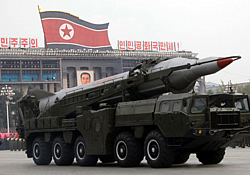
The Musudan IRBM is listed as “fielded” even though the missile, according to the U.S. Intelligence Community, has never been flight tested. In this case, “fielded” apparently means it has appeared but not that it is operational or necessarily deployed with the armed forces.
The Mushudan is listed as “fielded,” similar to the Russian SS-27, even though the North Korean missile has never been flight tested.
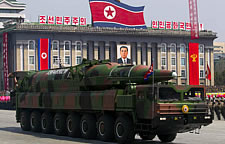
The KN-08 ICBM, which was displayed at the May 2012 parade, was widely seen by non-governmental analysts to be a mockup. But AFGSC obviously believes the weapon is real and expected to be “fielded” within the next five years. There were rumors in January 2013 that North Korea had started moving KN-08 launchers around the country at the beginning of a saber-rattling campaign that lasted through March.
Finally, the AFGSC briefing also predicts that North Korea will field a nuclear warhead within the next five year. Whether this refers to North Korea’s first weaponized warhead or newer types is unclear.
United Kingdom
![]()
The UK section does not include any weapons modernizations, which doesn’t quite capture what’s going on. For example, Britain is deploying the modified W76-1/Mk4A, which British officials have stated will increase the targeting capability of the Trident II D5 SLBM. Accordingly, a warhead icon has been added to the U.K. bar above.
Moreover, although the final approval has not been given yet, Britain is planning construction of a new SSBN to replace the current fleet of four Vanguard-class SSBNs. The missile section is under development in the United States. The new submarine will also receive the life-extended D5 SLBM.
United States
![]()
The U.S. section also does not show any nuclear modernizations, which glosses over important upgrades.
For example, the Minuteman III ICBM is in the final phases of a decade-long multi-billion dollar life-extension program that will extend the weapon to 2030. Privately, Air Force officials are joking that everything except the shell is new. Accordingly, a fielded ICBM icon has been added to the U.S. bar.
Moreover, full-scale production and deployment of the W76-1/Mk4A warhead on the Trident II D5 SLBM is underway. The combination of the new reentry body with the D5 increases the targeting capability of the weapon. Accordingly, a fielded warhead icon has been added to the U.S. bar.
In addition, from 2017 the U.S. Navy will begin deploying a modified life-extended version of the D5 SLBM (D5LE) on Ohio-class SSBNs. Production of the D5LE is currently underway, which will be “more accurate” and “provide flexibility to support new missions,” according to the navy and contractor. Accordingly, a forthcoming SLBM icon has been added to the U.S. bar.
Finally, the United States has begun design of a new SSBN class, a long-range bomber, a long-range cruise missile, a fighter-bomber, a guided standoff gravity bomb, and is studying a replacement-ICBM.
Hardly the dormant nuclear enterprise portrayed in the briefing.
France
![]()
France is listed with four nuclear modernizations, all well known: Triomphant SSBN, M51 SLBM, ASMP-A ALCM, and a new warhead.
The introduction of the ASMP-A is complete but the M51 SLBM is still replacing M45 SLBMs on the SSBN fleet.
The warhead section only appears to include the TNA warhead for the ASMP-A but ignores that France from 2015 will begin replacing the TN75 warhead on the M51 SLBM with the new TNO.
What is Meant by Nuclear and Fielded?
The AFGSC briefing is unclear and somewhat confusing about what constitutes a nuclear-capable weapon system and when it is considered “fielded.”
AFGSC confirmed to me that the slide only lists nuclear-capable weapon systems.
Air Force regulations are pretty specific about what constitutes a nuclear-capable unit. According to Air Force Instruction 13-503 regarding the Nuclear-Capable Unit Certification, Decertification and Restriction Program, a nuclear-capable unit is “a unit or an activity assigned responsibilities for employing, assembling, maintaining, transporting or storing war reserve (WR) nuclear weapons, their associated components and ancillary equipment.”
This is pretty straightforward when it comes to Russian weapons but much more dubious when describing North Korean systems. Russia is known to have developed miniaturized warheads and repeatedly test-flown them on missiles that are operationally deployed with the armed forces.
North Korea is a different matter. It is known to have detonated three nuclear test devices and test-launched some missiles, but that’s pretty much the extent of it. Despite its efforts and some worrisome progress, there is no public evidence that it has yet turned the nuclear devices into miniaturized warheads that are capable of being employed successfully by its ballistic or cruise missiles. Nor is there any public evidence that nuclear-armed missiles are operationally deployed with the armed forces.
Moreover, the U.S. Intelligence Community has recently issued strong statements that cast doubt on whether North Korea has yet mastered the technology to equip missile with nuclear warheads. James Clapper, the director of National Intelligence, testified before the Senate on April 18, 2013, that despite its efforts, “North Korea has not, however, fully developed, tested, or demonstrated the full range of capabilities necessary for a nuclear-armed missile.”
So how can the AFGSC briefing label North Korean ballistic missiles as nuclear-capable – and also conclude that the KN-09 cruise missile is nuclear-capable?
There are similar questions about the determination of when a weapon system is “fielded.” Does it mean it is fielded with the armed forces or simply that it has been seen? For example, how can a North Korean Musudan IRBM be considered fielded similarly to a Russia SS-27 ICBM?
Or how can the Musudan IRBM be identified as already “fielded” when it has not been flight tested and only displayed on parade, when the KN-08 is identified as not “fielded” even though it has also not been flight tested, also been displayed on parade, and even moved around North Korea?
Finally, how can the Russian Bulava SLBM and Kalibr SLCM be listed as “fielded” when their delivery platforms (Borei SSBN and Yasen SSGN, respectively) are listed as not fielded?
These inconsistencies cast doubt on the quality of the AFGSC briefing and whether it represents the conclusion of a coordinated Intelligence Community assessment, or simply is an effort to raise money in Congress for modernizing U.S. bombers and ICBMs.
Implications and Recommendations
There are still more than 17,000 nuclear weapons in the world and all the nuclear weapon states are busy maintaining and modernizing their arsenals. After Russia and the United States have insisted for decades that nuclear cruise missiles are essential for their security, the AFGSC briefing claims that China and North Korea are now trying to follow their lead.
For some, the AFGSC briefing will be (and probably already is) used to argue that nuclear threats against the United States and its allies are increasing and that Congress therefore should oppose further reductions of U.S. nuclear forces and instead approve modernizations of the remaining arsenal.
But Russia is not expanding its nuclear forces, the nuclear arsenals of China and Pakistan are much smaller than U.S. forces, and North Korea is in its infancy as a nuclear weapon state.
Instead, the rampant nuclear modernizations shown in the briefing symbolize struggling arms control and non-proliferation regimes that appear inadequate to turn the tide. They are being undercut by recommitments of a small group of nuclear weapon states to retain and improve nuclear forces for the indefinite future. The modernizations are partially being sustained by non-nuclear weapon states – often the very same who otherwise say they want nuclear disarmament – that insist on being protected by nuclear weapons.
The AFGSC briefing shows that there’s an urgent need for the international community to increase its pressure on the nuclear weapon states to curtail their nuclear programs. Especially limitations on MIRVed missiles are urgently needed. For its part, the Obama administration must reenergize its efforts to reduce the numbers and role of nuclear weapons.
There have been many nice speeches about reducing nuclear arsenals but too little progress on limiting the endless cycle of modernizations that sustain them.
Document: Air Force Global Strike Command Command Briefing
This publication was made possible by grants from the New-Land Foundation and Ploughshares Fund. The statements made and views expressed are solely the responsibility of the author.
Russian SSBN Fleet: Modernizing But Not Sailing Much
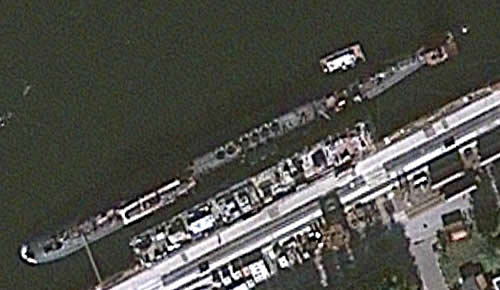
The second Borei-class SSBN (Alexander Nevsky) is fitting out at the Severodvinsk Naval Shipyard in northern Russia. Six of its 16 missile tubes are open on this August 2011 satellite image by DigitalGlobe/GoogleEarth.
By Hans M. Kristensen
The Russian ballistic missile submarine fleet is being modernized but conducting so few deterrent patrols that each submarine crew cannot be certain to get out of port even once a year.
During 2012, according to data obtained from U.S. Naval Intelligence under the Freedom of Information Act, the entire Russian fleet of nine ballistic missile submarines only sailed on five deterrent patrols.
The patrol level is barely enough to maintain one missile submarine on patrol at any given time.
The ballistic missile submarine force is in the middle of an important modernization. Over the next decade or so, all remaining Soviet-era ballistic missile submarines and their two types of sea-launched ballistic missiles will be replaced with a new submarine armed with a new missile (see also our latest Nuclear Notebook on Russian nuclear forces).
The new fleet will carry more nuclear warheads than the one it replaces, however, because the Russian military is trying to maintain parity with the larger U.S. nuclear arsenal.
Sluggish Deterrent Patrols
The operational tempo of the Russian SSBN fleet – measured in the number of deterrent patrol conducted each year – has declined significantly – actually plummeted – since the end of the Cold War.
At their peak in 1984 – the year after the Russian military became convinced that the NATO exercise Able Archer was in fact disguised preparations for a nuclear first strike against the Soviet Union, Russian SSBNs carried out 102 patrols. Under Mikhail Gorbachev, operations quickly declined in the second half of the 1980s. But even as the Warsaw Pact collapsed and the Berlin Wall fell in 1989, the fleet was able to muster a slight comeback in 1990.
As the Cold War officially ended in 1990, the Soviet Union dissolved and Russia descended into financial recession, the SSBN force increasingly stayed in port until in 2002, when no deterrent patrols were conducted all.
Since then, the performance has been a mixed bag. After a slight whiff of new life with 10 patrols in 2008 (up from 3 in 2007), the number of SSBN patrols has declined again to around five in 2012.
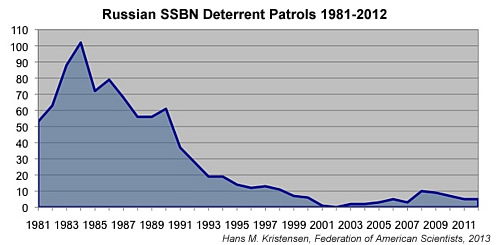
The recent decline contrasts with the Russian Navy’s declaration last year that it would resume continuous deterrent patrols from mid-2012. Assuming the five patrols occurred throughout the year and not just in the last six months, the fleet would have had a hard time maintaining a continuous at-sea presence with only five patrols. Theoretically, it could be done if each patrol lasted an average of 73 days. That is how long a U.S. SSBN deploys on a good day. But Russian SSBNs are thought to do shorter patrols, probably 40-60 days each, in which case most of the five patrols would have had to occur between July and December to maintain continuous patrol from mid-2012.
Even if the navy were able to squeeze a more or less continuous at-sea presence out of the five patrols, it would at best have consisted of a single SSBN – not much for a fleet of nine submarines or demonstrating a convincing secure retaliatory capability.
Perhaps more significantly, the five deterrent patrols conducted in 2012 are not enough for each SSBN in the fleet to be able to conduct even one patrol a year. The five patrols by nine SSBNs indicate that only five or less submarines are active. That means that submarine crews do not get much hands-on training in how to operate the SSBNs so they actually have a chance to survive and provide a secure retaliatory strike capability in a crisis. Crews probably compensate for this by practicing alert operations at pier-side at their bases.
Unlike U.S. SSBNs, which can patrol essentially with impunity in the open oceans, Russian deterrent patrols are thought to take place in “strategic bastions” relatively close to Russia where the SSBNs can be protected by the Russian navy against the U.S. and British attack submarines that probably occasionally monitor their potential targets.
The Russian navy remembers all too well the 1980s when the aggressive U.S. Maritime Strategy envisioned using attack submarines to hunt down and destroy Soviet SSBNs early on in a conflict, a highly controversial strategy [see here and here] that could likely have triggered escalation to strategic nuclear war. Hunting Russian SSBNs is no longer a primary mission for U.S. attack submarines, but it is probably still part of the mission package and one that Russian planners cannot afford to ignore. As a result, Russian SSBNs probably continue to patrol in the areas used in the late-1980s and early-1990s (see map) to provide maximum protection.
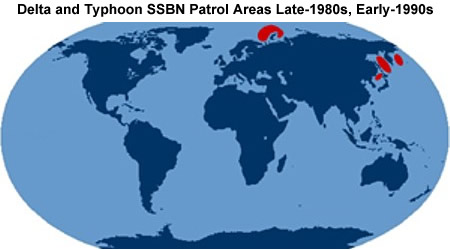
Force Structure
Russia currently operates 10 ballistic missile submarines (SSBNs), of which three Delta IIIs based in the Pacific are outdated and six Delta IVs based in the Barents Sea have recently been refurbished to serve for another decade or so. The 10th SSBN added in January 2013 is the first of a new type of Borei-class SSBNs that are scheduled to replace all Deltas by the mid/late-2020s.
The first Borei-class (Project 955) SSBN, Yuri Dolgoruki, entered service after more than 15 years of design and construction, marking the first time in 25 years that the Russian Navy had commissioned a new SSBN. A second Borei has been launched and a third is under construction. Russia has announced plans to build a total of eight Boreis. Each Borei is equipped with 16 SS-N-32 (Bulava) SLBMs, a missile that Russia has declared can carry up to six warheads.
The fourth and subsequent Borei-class SSBNs will be of an improved design, known as Borei-II or Project 955A). Russian news media is full of rumors that the improved Boreis will be equipped with 20 SLBMs instead of 16 on each of the first three boats. Some Russian officials dispute that, saying all Boreis will be equipped with 16 missiles.
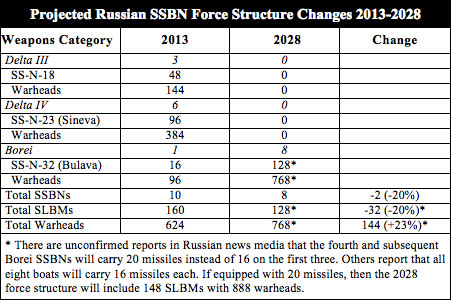
This force structure plan has implications for Russia’s nuclear posture and strategic priorities. The replacement of the Delta SSBNs with eight Borei SSBNs will reduce the size of the Russian SSBN fleet and the number of SLBMs, but result in a 23-percent increase in the number of sea-based warheads because the SS-N-32 carries more warheads than the SS-N-18 and SS-N-23 SLBMs it replaces.
In other words, Russia will be placing more eggs in fewer baskets at sea, which increases the importance of each SSBN – something strategists say is bad for crisis stability.
Conclusions and Implications
The Russian SSBN force is in the middle of a transition from Soviet-era weapons to a smaller but more warhead-heavy fleet of new submarines.
This means that the SSBN fleet will carry a growing portion of Russia’s strategic missile warheads – up from about a third today to nearly half by the mid-2020s.
The trend of increased warhead loading on sea-launched ballistic missiles is similar to the development on land where reduction of the Russian ICBM force will result in a greater portion of the remaining force being equipped with multiple warheads.
This is perhaps the most dominant trend of Russia’s nuclear forces today: fewer launchers but each carrying more warheads. Not that Russia will have more total nuclear warheads than before (their arsenal is declining), but that military planners have fallen for the temptation to place more nuclear eggs in each basket.
They appear to do so to compensate againt the larger U.S. nuclear missile force and its significant reserve of additional warheads. But it would be helpful if the Russian government would declare how many Borei-class SSBNs it plans to build in total and limit the number of missiles on each to 16.
The Russian modernization is motivating Cold Warriors in the U.S. Congress to argue that the United States should not reduce but modernize its nuclear forces. They are wrong for many reasons, not least because the two postures are very different.
The U.S. SSBN fleet is more modern with another 15 service years left in it, and it carries many more missiles that are much more reliable with more warheads. The U.S. could in fact easily reduce its SSBN fleet to ten boats, perhaps fewer.
Moreover, in contrast with U.S. SSBN operations, where each operational submarine conducts an average of 2-3 patrols each year, Russian SSBN crews do not get a lot of operational training with an average of less than one patrol per submarine per year.
Rather than opposing further reductions, U.S. lawmakers should support limitations on the growing asymmetry between U.S. and Russian strategic nuclear forces – an asymmetry that is significantly in the U.S. advantage – to help limit further concentration of nuclear warheads on Russia’s declining numbers of strategic missiles. That would actually help the national security interests of all.
See also: Russian nuclear forces, 2013
This publication was made possible by a grant from the Ploughshares Fund. The statements made and views expressed are solely the responsibility of the author.
PREPCOM Nuclear Weapons De-Alerting Briefing

By Hans M. Kristensen
Greetings from Geneva! I’m at the Palais des Nations for the second Preparatory Committee (PREPCOM) meeting for the 2015 Review Conference of the nuclear Non-Proliferation Treaty (NPT). I was invited by the Swiss and New Zealand UN Missions to brief our report Reducing Alert Rates of Nuclear Weapons.
With me on the panel was Richard Garwin, an FAS board member who for more than five decades has advised U.S. governments on nuclear weapons and other issues, and Gareth Evans, former Australian Foreign Minister and now Chancellor of the Australian National University.
The panel was co-chaired by Ambassador H.E. Dell Higgie, the head of the New Zealand UN Mission and Permanent Representative to the United Nations and Conference on Disarmament, and Ambassador Benno Laggner, the head of the Swiss Foreign Ministry’s Division for Security Policy and Ambassador for Nuclear Disarmament and Non-Proliferation. Switzerland and New Zealand have for several years spearheaded efforts in the United Nations to reduce the alert level of nuclear weapons.
I wrote the de-alerting report together with Matthew McKinzie who directs the nuclear program at the Natural Resources Defense Council. Click to download my briefing slides (7.6 MB) and prepared remarks.
New START Data: US Reductions Finally Picking Up; Russia Flatlining

By Hans M. Kristensen
After two years of stalling, the latest New START Treaty aggregate data released today by the State Department indicates that U.S. warhead reductions under the treaty are finally picking up.
Russia, which is already below the treaty limit, has been more or less flatlining over the past year.
Seen in perspective, however, the warhead reductions achieved under New START so far are not impressive: since the treaty entered into effect in February 2011, the world’s two largest nuclear weapons states – with combined stockpiles of nearly 10,000 warheads – have only reduced their deployed arsenals by a total of 203 warheads!

The data for the United States shows a reduction of 68 warheads compared with September 2012. Fourteen of those are probably “fake” warheads attributed to B-52G bombers that are counted as deployed under the treaty, although they are neither deployed nor nuclear tasked anymore. The remaining 54-warhead reduction probably reflects downloading of the remaining MIRVed ICBMs (and some fluctuations in SLBM loadings of SSBNs in refit). Another 104 warheads will have to be reduced over the next five years to meet the treaty limit of 1,550 deployed accountable warheads by 2018 (although many of those will come from reducing bombers that are not actually assigned nuclear weapons).
Russia, which has been below the ceiling of 1,550 deployed accountable strategic warheads for the past year, appears to be flatlining. It is counted with a 19-warhead reduction compared with September 2012. But that number is too low say whether it reflects real reductions due to retirement of missiles or just fluctuations in SLBM loadings on SSBNs in refit. Russia increased its delivery vehicles slightly due to deployment of the first new Borei-class SSBN.
What’s most striking about the data, though, is the significant asymmetry in delivery vehicles: the United States has 300 deployed delivery vehicles more than Russia, a disparity that causes Russia to deploy more warheads on each delivery vehicle and fuels worst-case military planning and paranoia about treaty break-out plans.
A clear objective for the next arms control agreement between the United States and Russia will have to be to reduce the U.S. delivery vehicles and Russian warhead loading to improve stability of the postures.
Moreover, with only 203 deployed warheads cut since the New START Treaty entered into effect more than two years ago, and nearly 10,000 nuclear warheads remaining in their stockpiles combined, there is clearly a need for the United States and Russia to speed up implementation of the treaty and agree to significant additional reductions.
[Details about the reductions are murky because the aggregate data only includes overall numbers, and does not specify how many of each delivery system are counted. A more detailed analysis will follow when the full detailed U.S. data becomes available in a few weeks.]
Background: See previous New START Treaty data analysis
This publication was made possible by a grant from the Ploughshares Fund. The statements made and views expressed are solely the responsibility of the author.
Q&A Session on Recent Developments in U.S. and NATO Missile Defense with Dr. Yousaf Butt and Dr. George Lewis
Dr. Yousaf Butt, a nuclear physicist, is professor and scientist-in-residence at the James Martin Center for Nonproliferation Studies at the Monterey Institute of International Studies. The views expressed are his own.
Dr. George N. Lewis is a senior research associate at the Judith Reppy Institute for Peace and Conflict Studies at Cornell University.
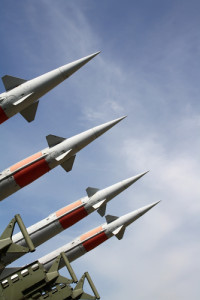 Researchers from the Federation of American Scientists (FAS) asked two physicists who are experts in missile defense issues, Dr. Yousaf Butt and Dr. George Lewis, to weigh in on last week’s announcements on missile defense by the Obama administration.
Researchers from the Federation of American Scientists (FAS) asked two physicists who are experts in missile defense issues, Dr. Yousaf Butt and Dr. George Lewis, to weigh in on last week’s announcements on missile defense by the Obama administration.
Before exploring their reactions and insights, it is useful to identify salient elements of U.S. missile defense and place the issue in context. There are two main strategic missile defense systems fielded by the United States: one is based on large high-speed interceptors called Ground-Based Interceptors or “GBI’s” located in Alaska and California and the other is the mostly ship-based NATO/European system. The latter, European Phased Adaptive Approach (EPAA) to missile defense is designed to deal with the threat posed by possible future Iranian intermediate- and long-range ballistic missiles to U.S. assets, personnel, and allies in Europe – and eventually attempt to protect the U.S. homeland.
The EPAA uses ground-based and mobile ship-borne radars; the interceptors themselves are mounted on Ticonderoga class cruisers and Arleigh Burke class destroyers. Two land-based interceptor sites in Poland and Romania are also envisioned – the so-called “Aegis-ashore” sites. The United States and NATO have stated that the EPAA is not directed at Russia and poses no threat to its nuclear deterrent forces, but as outlined in a 2011 study by Dr. Theodore Postol and Dr. Yousaf Butt, this is not completely accurate because the system is ship-based, and thus mobile it could be reconfigured to have a theoretical capability to engage Russian warheads.
Indeed, General James Cartwright has explicitly mentioned this possible reconfiguration – or global surge capability – as an attribute of the planned system: “Part of what’s in the budget is to get us a sufficient number of ships to allow us to have a global deployment of this capability on a constant basis, with a surge capacity to any one theater at a time.”
In the 2011 study, the authors focused on what would be the main concern of cautious Russian military planners —the capability of the missile defense interceptors to simply reach, or “engage,” Russian strategic warheads—rather than whether any particular engagement results in an actual interception, or “kill.” Interceptors with a kinematic capability to simply reach Russian ICBM warheads would be sufficient to raise concerns in Russian national security circles – regardless of the possibility that Russian decoys and other countermeasures might defeat the system in actual engagements. In short, even a missile defense system that could be rendered ineffective could still elicit serious concern from cautious Russian planners. The last two phases of the EPAA – when the higher burnout velocity “Block II” SM-3 interceptors come on-line in 2018 – could raise legitimate concerns for Russian military analysts.
A Russian news report sums up the Russian concerns: “[Russian foreign minister] Lavrov said Russia’s agreement to discuss cooperation on missile defense in the NATO Russia Council does not mean that Moscow agrees to the NATO projects which are being developed without Russia’s participation. The minister said the fulfillment of the third and fourth phases of the U.S. ‘adaptive approach’ will enter a strategic level threatening the efficiency of Russia’s nuclear containment forces.” [emphasis added]
With this background in mind, FAS’ Senior Fellow on State and Non-State Threat, Charles P. Blair (CB), asked Dr. Yousaf Butt (YB) and Dr. George Lewis (GL) for their input on recent developments on missile defense with eight questions.
Q: (CB) Last Friday, Secretary of Defense Hagel announced that the U.S. will cancel the last Phase – Phase 4 – of the European Phased Adaptive Approach (EPAA) to missile defense which was to happen around 2021. This was the phase with the faster SM-3 “Block IIB” interceptors. Will this cancellation hurt the United State’s ability to protect itself and Europe?
A: (YB) No, because the “ability” you mention was always hypothetical. The Achilles’ Heel of all versions of the SM-3 (Block I A/B and Block II A/B) interceptors — indeed of “midcourse” missile defense, in general, is that it is straightforward to defeat the system using cheap decoy warheads. The system simply does not have a robust ability to discriminate a genuine warhead from decoys and other countermeasures. Because the intercepts take place in the vacuum of space, the heavy warhead and light decoys travel together, confusing the system’s sensors. The Pentagon’s own scientists at the Defense Science Board said as much in 2011, as did the National Academy of Sciences earlier this year.
Additionally, the system has never been successfully tested in realistic conditions stressed by the presence of decoys or other countermeasures. The majority of the system would be ship-based and is not known to work beyond a certain sea-state: as you might imagine, it becomes too risky to launch the interceptors if the ship is pitching wildly.
So any hypothetical (possibly future) nuclear-armed Middle Eastern nation with ICBMs could be a threat to the Unites States or Europe whether we have no missile defenses, have just Block I interceptors, or even the Block II interceptors. Since the interceptors would only have offered a false sense of security, nothing is lost in canceling Phase 4 of the EPAA. In fact, the other phases could also be canceled with no loss to U.S. or NATO security, and offering considerable saving of U.S. taxpayer’s money.
Q: (CB) What about Iran and its alleged desire to build ICBMs? Having just launched a satellite in January, could such actions act as a cover for an ICBM?
A: (YB) The evidence does not point that way at all. It points the other way. For instance, the latest Congressional Research Service (CRS) report on Iran’s missile program observes: (emphasis added)
“Iran also has a genuine and ambitious space launch program, which seeks to enhance Iran’s national pride, and perhaps more importantly, its international reputation as a growing advanced industrial power. Iran also sees itself as a potential leader in the Middle East offering space launch and satellite services. Iran has stated it plans to use future launchers for placing intelligence gathering satellites into orbit, although such a capability is a decade or so in the future. Many believe Iran’s space launch program could mask the development of an intercontinental ballistic missile (ICBM) – with ranges in excess of 5,500 km that could threaten targets throughout Europe, and even the United States if Iran achieved an ICBM capability of at least 10,000 km. ICBMs share many similar technologies and processes inherent in a space launch program, but it seems clear that Iran has a dedicated space launch effort and it is not simply a cover for ICBM development. Since 1999, the U.S. Intelligence Community (IC) has assessed that Iran could test an ICBM by 2015 with sufficient foreign assistance, especially from a country such as China or Russia (whose support has reportedly diminished over the past decade). It is increasingly uncertain whether Iran will be able to achieve an ICBM capability by 2015 for several reasons: Iran does not appear to be receiving the degree of foreign support many believe would be necessary, Iran has found it increasingly difficult to acquire certain critical components and materials because of sanctions, and Iran has not demonstrated the kind of flight test program many view as necessary to produce an ICBM.”
Furthermore, the payload of Iran’s space launch vehicles is very low compared to what would be needed for a nuclear warhead — or even a substantial conventional warhead. For instance, Omid, Iran’s first satellite weighed just 27 kg [60 pounds] and Rasad-1, Iran’s second satellite weighed just 15.3 kilograms [33.74 pound], whereas a nuclear warhead would require a payload capacity on the order of 1000 kilograms. Furthermore, since launching an ICBM from Iran towards the United States or Europe requires going somewhat against the rotation of Earth the challenge is greater. As pointed out by missile and space security expert Dr. David Wright, an ICBM capable of reaching targets in the United States would need to have a range longer than 11,000 km. Drawing upon the experience of France in making solid-fuel ICBMs, Dr. Wright estimates it may take 40 years for Iran to develop a similar ICBM – assuming it has the intention to kick off such an effort. A liquid fueled rocket could be developed sooner, but there is little evidence in terms of rocket testing that Iran has kicked off such an effort.
In any case, it appears that informed European officials are not really afraid of any hypothetical Iranian missiles. For example, the Polish foreign minister, Radoslaw Sikorski, once made light of the whole scenario telling Foreign Policy, “If the mullahs have a target list we believe we are quite low on it.” As if to emphasize that point, the Europeans don’t appear to be pulling their weight in terms of funding the system. “We love the capability but just don’t have the money,” one European military official stated in reference to procuring the interceptors.
Similarly, the alleged threat from North Korea is also not all that urgent.
It seems U.S. taxpayers are subsidizing a project that will have little national security benefits either for the United States or NATO countries. In contrast, it may well create a dangerous false sense of security. It has already negatively impacted ties with Russia and China.
Q: (CB) Isn’t Iran’s alleged nuclear weapons program a big concern in arguing for a missile defense? Prime Minister Netanyahu of Israel said Iran may cross some red-line in the summer?
A: (YB) Iran’s nuclear program could be a concern, but the latest report from the Office of the Director of National Intelligence (ODNI) says Iran has not even decided to make nuclear weapons yet. Building, testing and miniaturizing a warhead to fit on a missile takes years – after a country decides to do so. In any case, no matter how scary that hypothetical prospect, one would not want a missile defense system that could be easily defeated to address that alleged eventual threat. Even if you believe the threat exists now, you may want a system that is effective, not a midcourse system that has inherent flaws.
Incidentally, the DNI’s report explicitly states: “we assess Iran could not divert safeguarded material and produce a weapon-worth of WGU [weapons grade uranium] before this activity is discovered.” As for the red-line drawn by Prime Minister Netanyahu: his track-record on predicting Iranian nuclear weaponization has been notoriously bad. As I point out in a recent piece for Reuters, in 1992 Mr. Netanyahu said Iran was three to five years from a bomb. I assess he is still wrong, more than 20 years later.
Lastly, even if Iran (or other nations) obtained nuclear weapons in the future, they can be delivered in any number of ways- not just via missiles. In fact, nuclear missiles have the benefit of being self-deterring – nations are actually hesitant to use nuclear weapons if they are mated to missiles. Other nations know that the United States can pinpoint the launch sites of missiles. The same cannot be said of a nuclear device placed in a sailboat, a reality that could precipitate the use of that type of device due to the lack of attribution. So one has to carefully consider if it makes sense to dissuade the placement of nuclear weapons on missiles. If an adversarial nation has nuclear weapons it may be best to have them mated to missiles rather than boats.
Q: (CB) It seems that the Russians are still concerned about the missile defense system, even after Defense Secretary Hagel said that the fourth phase of EPAA plan is canceled. Why are they evidently still concerned?
A: (YB) The Russians probably have four main concerns with NATO missile defense, even after the cancellation of Phase 4 of EPAA. For more details on some of these please see the report Ted Postol and I wrote.
1. The first is geopolitical: the Russians have never been happy about the Eastward expansion of NATO and they see joint U.S.-Polish and U.S.-Romanian missile defense bases near their borders as provocative. This is not to say they are right or wrong, but that is most likely their perception. These bases are to be built before Phase 4 of the EPAA, so they are still in the plans.
2. The Russians do not concur with the alleged long-range missile threat from Iran. One cannot entirely blame them when the Polish foreign minister himself makes light of the alleged threat saying, “If the mullahs have a target list we believe we are quite low on it.” Russian officials are possibly confused and their military analysts may even be somewhat alarmed, mulling what the real intent behind these missile defense bases could be, if – in their assessment – the Iran threat is unrealistic, as in fact was admitted to by the Polish foreign minister. The Russians also have to take into account unexpected future changes which may occur on these bases, for instance: a change in U.S. or Polish or Romanian administrations; a large expansion of the number or types of interceptors; or, perhaps even nuclear-tipped interceptors (which were proposed by former Defense Secretary Rumsfeld about ten years ago).
3. Russian military planners are properly hyper-cautious, just like their counterparts at the Pentagon, and they must assume a worst-case scenario in which the missile defense system is assumed to be effective, even when it isn’t. This concern likely feeds into their fear that the legal balance of arms agreed to in New START may be upset by the missile defense system.
Their main worry could be with the mobile ship-based platforms and less with the European bases, as explained in detail in the study Ted Postol and I did. Basically, the Aegis missile defense cruisers could be placed off of the East Coast of the U.S. and – especially with Block IIA/B interceptors –engage Russian warheads. Some statements from senior U.S. officials probably play into their fears. For instance, General Cartwright has been quoted as saying, “part of what’s in the budget is to get us a sufficient number of ships to allow us to have a global deployment of this capability on a constant basis, with a surge capacity to any one theater at a time.” To certain Russian military planners’ ears that may not sound like a limited system aimed at a primitive threat from Iran.
Because the mobile ship-based interceptors (hypothetically placed off of the U.S. East Coast ) could engage Russian warheads, Russian officials may be able claim this as an infringement on New START parity.
Missile defenses that show little promise of working well can, nevertheless, alter perceptions that the strategic balance between otherwise well-matched states is stable. Even when missile defenses reveal that they possess little, if any technical capabilities, they can still cause cautious adversaries and competitors to react as if they might work. The United States’ response to the Cold War era Soviet missile defense system was similarly overcautious.
4. Finally, certain Russian military planners may worry about the NATO EPAA missile defense system because in Phase 3, the interceptors are to be based on the SM-3 Block IIA booster. The United States has conducted research using this same type of rocket booster as the basis of a hypersonic-glide offensive strike weapon called ArcLight. Because such offensive hyper-glide weapons could fit into the very same vertical launch tubes – on the ground in Poland and Romania, or on the Aegis ships – used for the defensive interceptors, the potential exists for turning a defensive system into an offensive one, in short order. Although funding for ArcLight has been eliminated in recent years, Russian military planners may continue to worry that perhaps the project “went black” [secret], or that it may be resuscitated in the future. In fact, a recent Federal Business Opportunity (FBO) for the Department of the Navy calls for hypersonic weapons technologies that could fit into the same Mk. 41 Vertical Launch System (VLS) tubes that the SM-3 missile defense interceptors are also placed in.
To conclude, advocates of missile defense who say we need cooperation on missile defense to improve ties with Russia have the logic exactly backward: In large part, the renewed tension between Russia and the United States is about missile defense. Were we to abandon this flawed and expensive idea, our ties with Russia — and China — would naturally improve. And, in return, they could perhaps help us more with other foreign policy issues such as Iran, North Korea, and Syria. As it stands, missile defense is harming bilateral relations with Russia and poisoning the well of future arms control.
Q: (CB) Adding to the gravity of Secretary Hagel’s announcement , last week China expressed worry about Ground-Based Interceptors, the Bush administration’s missile defense initiative in Poland discarded by the Obama administration in 2009, in favor of Phase 4 of the EPAA. Why is there concern with not only the Aegis ship-based system, but also the GBIs on the West Coast?
A: (YB) Like the Russians, Chinese military analysts are also likely to assume the worst-case scenario for the system (ie. that it will work perfectly) in coming up with their counter response . Possessing a much smaller nuclear arsenal than Russia or the United States, to China, even a few interceptors can be perceived as making a dent in their deterrent forces. And I think the Chinese are likely worried about both the ship-based Aegis system as well as the West Coast GBIs.
And this concern on the part of the Chinese is nothing new. They have not been as vocal as the Russians, but it is evident they were never content with U.S. and NATO plans. For instance, the 2009 Bipartisan Strategic Posture Commission pointed out that “China may already be increasing the size of its ICBM force in response to its assessment of the U.S. missile defense program.” Such stockpile increases, if they are taking place, will probably compel India, and, in turn, Pakistan to also ramp up their nuclear weapon numbers.
The Chinese may also be looking to the future and think that U.S. defenses may encourage North Korea to field more missiles than it may originally have been intending – if and when the North Koreans make long range missiles – to make sure some get through the defense system. This would have an obvious destabilizing effect in East Asia which the Chinese would rather avoid.
Some U.S. media outlets have also said the ship-based Aegis system could be used against China’s DF-21D anti-ship missile, when the official U.S. government position has always been that the system is only intended only against North Korea (in the Pacific theater). Such mission creep could sound provocative to the Chinese, who were told that the Aegis system is not “aimed at” China.
In reality, while the Aegis system’s sensors may be able to help track the DF-21D it is unlikely that the interceptors could be easily modified to work within the atmosphere where the DF-21D’s kill vehicle travels. (It could perhaps be intercepted at apogee during the ballistic phase). A recent CRS report was quite explicit that the DF-21D is a threat which remains unaddressed in the Navy: “No Navy target program exists that adequately represents an anti-ship ballistic missile’s trajectory,’ Gilmore said in the e-mail. The Navy ‘has not budgeted for any study, development, acquisition or production’ of a DF-21D target, he said.”
Chinese concerns about U.S. missile defense systems are also a source of great uncertainty, reducing Chinese support for promoting negotiations on the Fissile Material Cutoff Treaty (FMCT). China’s leaders may wish to maintain the option of future military plutonium production in response to U.S. missile defense plans.
The central conundrum of midcourse missile defense remains that while it creates incentives for adversaries and competitors of the United States to increase their missile stockpiles, it offers no credible combat capability to protect the United States or its allies from this increased weaponry.
Q: (CB) Will a new missile defense site on the East Coast protect the United States? What would be the combat effectiveness of an East Coast site against an assumed Iranian ICBM threat?
A: (GL) I don’t see any real prospect for even starting a program for interceptors such as the [East Coast site] NAS is proposing any time soon in the current budget environment, and even if they did it probably would not be available until the 2020s. The recent announcement of the deployment of additional GBI interceptors is, in my view, just cover for getting rid of the Block II Bs, and was chosen because it was relatively ($1+ billion) inexpensive and could be done quickly.
The current combat effectiveness of the GBIs against an Iranian ICBM must be expected to be low. Of course there is no current Iranian ICBM threat. However, the current GMD system shows no prospect of improved performance against any attacker that takes any serious steps to defeat it as far out in time, as plans for this system are publicly available. Whether the interceptors are based in Alaska or on the East Coast makes very little difference to their performance.
Q: (CB) There were shortcomings reported by the Defense Science Board and the National Academies regarding the radars that are part of the system. Has anything changed to improve this situation?
A: (GL) With respect to radars, the main point is that basically nothing has happened. The existing early warning radars can’t discriminate [between real warheads and decoys]. The only radar that could potentially contribute to discrimination, the SBX, has been largely mothballed.
Q: (CB) Let’s say the United States had lots of money to spend on such a system, would an East Coast site have the theoretical ability to engage Russian warheads? Regardless of whether Russia could defeat the system with decoys or countermeasures, does the system have an ability to reach or engage the warheads? In short, could such a site be a concern for Russia?
A: (YB) If you have a look at Fig 8(a) and 8(b) in the report Ted Postol and I wrote you’ll see pretty clearly why an East Coast site might be a concern for Russia, especially with faster interceptors that are proposed for that site. Now I’m not saying it necessarily should be a concern – because they can defeat the system rather easily – but it may be. Whether they object to it or not vocally depends on other factors also. For instance, such a site will obviously not be geopolitically problematic for the Russians.
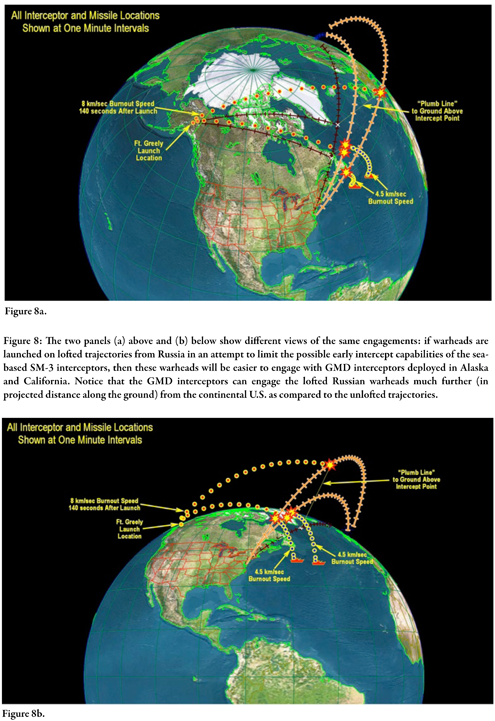
Figures 8(a) and 8(b) from the FAS Special Report Upsetting the Reset: The Technical Basis of Russian Concern Over NATO Missile Defense, by Yousaf Butt and Theodore Postol (p. 27).
Meteors Against Nukes

The meteor impacted near large Russian nuclear weapons facilities..
By Hans M. Kristensen
When the news media reported that a meteor had exploded over Chelyabinsk in Russia, the location name sounded familiar: the region is home to some of Russia’s most important nuclear weapons production and storage facilities.
Impact sites still have to be found but one reportedly was Chebarkul Lake, some 72 kilometers (45 miles) southwest of the city of Chelyabinsk. Another piece impacted near the town of Zlatoust some 80 kilometers (49 miles) to the northwest.
Approximately 88 kilometers (55 miles) northeast of Chebarkul Lake is Chelyabinsk-65 (Mayak), a plutonium production and fissile material storage complex. Another 40 miles to the north is Chelyabinsk-70 (Snezhinsk), a nuclear warhead design and storage complex.
Right in the meteor’s path, approximately 115 kilometers (72 miles) southwest of Chebarkul Lake, is Zlatoust-36, one of the two main warhead assembly and disassembly facilities in Russia. Adjacent to the facility is a national-level nuclear weapons storage site.
The odds of a meteor hitting one of these nuclear weapons production or storage site are probably infinitely small, but on a cosmic scale it got pretty close. Just how much damage a direct hit of a sizable chunk of the meteor could have caused is unknown, but the 17-meter (55 feet) meteor reportedly released energy equivalent to nearly 500 kilotons of TNT. That’s roughly the explosive yield of one of the W88 warheads carried on Trident II missiles onboard U.S. ballistic missile submarines.
This publication was made possible by a grant from the Ploughshares Fund. The statements made and views expressed are solely the responsibility of the author.
New Report: Reducing Alert Rates of Nuclear Weapons
.By Hans M. Kristensen
The United States and Russia have some 1,800 nuclear warheads on alert on ballistic missiles that are ready to launch in a few minutes, according to a new study published by UNIDIR. The number of U.S. and Russian alert warheads is greater than the total nuclear weapons inventories of all other nuclear weapons states combined.
The report Reducing Alert Rates of Nuclear Weapons is co-authored by Matthew McKinzie from the Natural Resources of Defense Council and yours truly.
France and Britain also keep some of their nuclear force on alert, although at lower readiness levels than the United States and Russia. No other nuclear weapon state has nuclear weapons on alert.
The report concludes that the warning made by opponents of de-alerting, that it could trigger a re-alerting race in a crisis that count undermine stability, is a “straw man” argument that overplays risks, downplays benefits, and ignores that current alert postures already include plans to increase readiness and alert rates in a crisis.
According to the report, “while there are risks with alerted and de-alerted postures, a re-alerting race that takes three months under a de-alerted posture is much preferable to a re-alerting race that takes only three hours under the current highly alerted posture. A de-alerted nuclear posture would allow the national leaders to think carefully about their decisions, rather than being forced by time constraints to choose from a list of pre-designated responses with catastrophic consequences.”
During his election campaign, Barack Obama promised to work with Russia to take nuclear weapons off “hair-trigger” alert, but the 2010 Nuclear Posture Review (NPR) instead decided to keep the existing alert posture. The post-NPR review that has now been completed but has yet to be announced hopefully will include a reduction of the alert level, not least because the Intelligence Community has concluded that a Russian surprise first strike is unlikely to occur.
The UNIDIR report finds that the United States and Russia previously have reduce the alert levels of their nuclear forces and recommends that they continue this process by removing the remaining nuclear weapons from alert through a phased approach to ensure stability and develop consultation and verification measures.
Full report: Reducing Alert Rates of Nuclear Weapons (FAS mirror)
This publication was made possible by a grant from the Swiss Government. General nuclear forces research is supported by the Ploughshares Fund. The statements made and views expressed are solely the responsibility of the authors.
Non-Strategic Nuclear Weapons Discussed in Warsaw

The conference was held in this elaborate room at the Intercontinental Warsaw hotel.
By Hans M. Kristensen
In early February, I participated in a conference in Warsaw on non-strategic nuclear weapons. The conference was organized by the Polish Institute of International Affairs, the Norwegian Institute for Defense Studies, and the Carnegie Endowment for International Peace. It was supported by the Ministry of Foreign Affairs of Norway and the Ministry of Foreign Affairs of Poland, with the participation of the U.S. State Department.
The conference had very high-level government representation from the United States and NATO, and included non-governmental experts from the academic and think-tank communities in Russia and NATO countries. The Russian government unfortunately did not send participants.
The United States and NATO want to broaden the arms control agenda to non-strategic nuclear weapons, which have so far largely eluded limitations and verification. The objective of the conference was to try to identify options for how NATO and Russia might begin to discuss confidence-building measures and eventually limitations on non-strategic nuclear weapons.
The conference commissioned eight working papers to form the basis for the discussions. My paper, which focused on identifying common definitions for categories of non-strategic nuclear weapons, recommended starting with air-delivered weapons as the only compatible category for negotiations on U.S-Russian non-strategic nuclear weapons.
Background: Working papers and lists of participants are available on the PISM web site. For background on non-strategic nuclear weapons, see this FAS report.
This publication was made possible by a grant from the Ploughshares Fund. The statements made and views expressed are solely the responsibility of the author.
Options for Reducing Nuclear Weapons Requirements
By Hans M. Kristensen
With the ink barely dry on the New START Treaty, Jeff Smith at the Center for Public Integrity reports that the Obama administration has determined that the United States can meet its national and international security requirements with 1,000-1,100 deployed strategic nuclear warheads – 450-550 warheads less than planned under the New START Treaty.
The administration is exploring how to get Russian agreement to the reductions without a new treaty, according to the New York Times. That would avoid a new agreement being held hostage to conservative Cold Warriors in Congress who fought ratification of the New START Treaty. Their efforts will be complicated by the fact that the U.S. military (and others) backs the reduced force level.
This is great news that reaffirms the administration’s commitment to continuing reducing excessive nuclear force levels. The fact that the new force level ended up closer to 1,000 than 1,200 warheads continues the 30 percent step-by-step reduction trend of the New START Treaty. The new initiative apparently also seeks reductions of non-deployed and non-strategic nuclear weapons, although it is unclear whether this is part of the first phase of the effort.
The lower force level has the potential to save billions of dollars, but how much depends on how the administration decides to implement it.
Reduction Options
The United States could meet the lower force level simply by reducing the warhead loading on ballistic missile submarines but without changing the force structure planned under the New START Treaty (see Table 1, Option 1). This would be a mistake because it would make it hard to convince Russia to join and it would save little money.
A more likely option would be to combine an ICBM reduction with a smaller SLBM download (Table 1, Option 2). That would reduce the ICBM force to 300 missiles and the overall force structure to 600 deployed launchers, or 100 less than under New START. Reducing the ICBM force to 300 from 400 planned under new START – a reduction of 150 from today’s 450 Minuteman III missiles – could be achieved by closing one of the three ICBM bases. A more likely option would be to spread job losses across the force by reducing the number of missile squadrons at each wing from three to two.
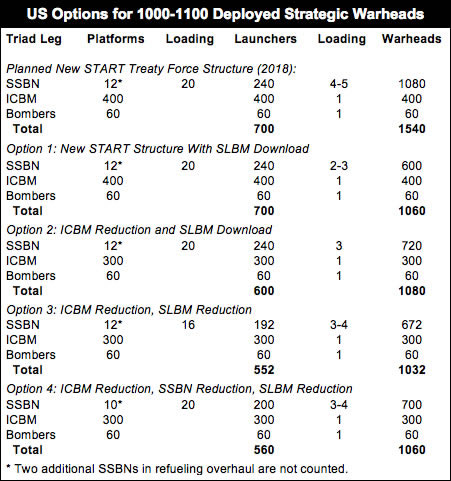
Another option would be to cut the ICBM force to 300 and reduce the missile loading on each SSBN from 20 planned under New START to 16, the same number planned for the next-generation SSBN (Table 1, Option 3). This option would reduce the force structure by nearly 150 deployed launchers below New START limit, thereby limiting the large advantage compared with Russia’s smaller force structure.
Yet another option could be to retire two SSBNs and reduce the ICBM force to 300. This option (Table 1, Option 4) would cancel the expensive refueling overhauls of the USS Wyoming (SSBN-742) and USS Louisiana (SSBN-743), retire the two submarines, and reduce the SSBN force to 12. Only 10 of those would be available for deployment.
How would a reduction to 1,000-1,100 deployed strategic warheads affect Russia’s posture? There are many uncertainties about how Russia’s missile forces will evolve over the next decade, but by the early 2020s the number of deployed missiles might decline to some 350 (down from around 450 today), or significantly less than the 700 permitted by the New START Treaty. So a new treaty would likely have little effect on reducing Russian deployed launchers.
The most important effect of a new limit of 1,000-1,100 deployed strategic warheads would be to reduce the warhead loading on Russia’s ICBMs. This is particularly important because Russia compensates for its smaller missile inventory by deployed more warheads on each missile. Again, the numbers are uncertain, but the lower warhead limit could potentially reduce Russian ICBM warheads by as much as 50 percent from roughly 800 estimated under the New START Treaty to approximately 400 warheads under the new reduced limit (see Table 2).
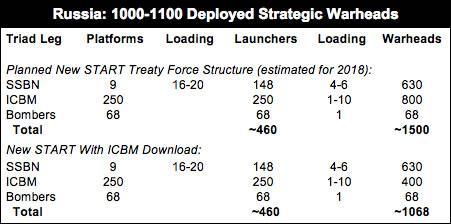
The only reason Russia would agree to this, it seems, is if the United States significantly reduced its deployed missiles and also reduced the number of warheads kept in reserve as a potential upload capability. The combination of a larger U.S. missile force with a large upload capacity is a significant breakout capability that undermines the changes of reaching a new agreement.
It is double important that a new agreement limits the upload capability because it could otherwise result in Russia also creating a “hedge” of non-deployed strategic warheads. Closing this “reconstitution” loophole in the arms reduction process is important for making nuclear reductions irreversible.
Effect on Role of Nuclear Weapons
How the reduced force level will reduce the role of nuclear weapons is yet unclear. President Obama stated in his Prague speech that he wanted to “put an end to Cold War thinking” by reducing “the role of nuclear weapons in our national security strategy.”
We have yet to hear how the new guidance puts and end to Cold War thinking in the way the military is required to plan for the potential use of nuclear weapons. Smith’s article states that the lower deployed warhead level would be achieved by U.S. Strategic Command “targeting fewer, but more important, military or political sites in Russia, China, and several other countries.”
If so, that would appear to refer to what is known as “nodal targeting,” in which planners focus targeting with nuclear forces on the most important facilities rather than holding at risk all facilities within a target category. Nodal targeting has been used for the past two decades to reduce warhead requirements and focus the strategic nuclear war plan on effects rather than on creating rubble.
The current nuclear war plan (OPLAN 8010, Strategic Deterrence and Global Strike [/blog/ssp/2010/02/warplan.php]) is designed to hold at risk nuclear and other weapons of mass destruction (WMD) forces, command and control, military and political leadership, and war supporting industries of six potential adversaries: Russia, China, North Korea, Iran, Syria (a country that might be dropped from the plan soon, if it hasn’t happened already), and a non-state WMD attack.
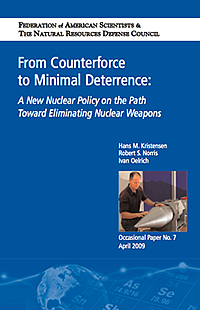 |
| The Obama administration’s nuclear targeting review appears to have considered a nuclear targeting option similar to what we proposed in this study in 2009. |
Focusing nodal targeting more would not necessarily change how nuclear targeting is performed. Nor does a force level itself of 1,000-1,100 deployed strategic warheads suggest that the day-to-day alert level of the forces has been reduced significantly. Indeed, Smith’s story describes that the review considered, but rejected, a proposal by the State Department, National Security Council staff, and Vice President Biden’s staff to consider changing targeting policy more fundamentally:
“A much steeper reduction, to around 500 total warheads, was debated within the administration last year, but rejected, sources said. Known as the “deterrence only” plan, it would have aimed U.S. warheads at a narrower range of targets related to an enemy’s economic capacity and no longer emphasized striking the enemy’s leadership and weaponry in the first wave of an attack. […]
Some officials at the State Department, the NSC staff, and Vice president Biden’s staff urged consideration of the smaller arsenal and new targeting policy, officials said. But ‘a small brake’ was applied by the Joint Chiefs of Staff chairman, Army Gen. Martin E. Dempsey, who worried that making such a major policy change was too risky at a moment of upheaval in conventional military strategy, and would create too much uncertainty among allies, said one of the sources with knowledge of the discussion.”
This appears to refer to a targeting policy similar to the one FAS and NRDC proposed in our 2009 study From Counterforce to Minimal Deterrence as a way of putting an end to Cold War thinking in nuclear planning. President Obama apparently “decided we did not need to do deterrence-only targeting now,” but did not rule it out for later.
Obviously, we have more work to do to put an end to Cold War thinking.
This publication was made possible by a grant from the Ploughshares Fund. The statements made and views expressed are solely the responsibility of the author.
Trimming Nuclear Excess
Despite enormous reductions of their nuclear arsenals since the Cold War, the United States and Russia retain more than 9,100 warheads in their military stockpiles. Another 7,000 retired – but still intact – warheads are awaiting dismantlement, for a total inventory of more than 16,000 nuclear warheads.
This is more than 15 times the size of the total nuclear arsenals of all the seven other nuclear weapon states in the world – combined.
The U.S. and Russian nuclear arsenals are far beyond what is needed for deterrence, with each side’s bloated force level justified only by the other’s excessive force level.
The FAS report – Trimming Nuclear Excess: Options for Further Reductions of U.S. and Russian Nuclear Forces – describes the status and 10-year projection for U.S. and Russian nuclear forces.
The report concludes that the pace of reducing nuclear forces appears to be slowing compared with the past two decades. Both the United States and Russia appear to be more cautious about reducing further, placing more emphasis on “hedging” and reconstitution of reduced nuclear forces, and both are investing enormous sums of money in modernizing their nuclear forces over the next decade.
Even with the reductions expected over the next decade, the report concludes that the United States and Russia will continue to possess nuclear stockpiles that are many times greater than the rest of the world’s nuclear forces combined.
New initiatives are needed to regain the momentum of the nuclear arms reduction process. The New START Treaty from 2011 was an important but modest step but the two nuclear superpowers must begin negotiations on new treaties to significantly curtail their nuclear forces. Both have expressed an interest in reducing further, but little has happened.
New treaties may be preferable, but reaching agreement on the complex inter-connected issues ranging from nuclear weapons to missile defense and conventional forces may be unlikely to produce results in the short term (not least given the current political climate in the U.S. Congress). While the world waits, the excess nuclear forces levels and outdated planning principles continue to fuel justifications for retaining large force levels and new modernizations in both the United States and Russia.
To break the stalemate and reenergize the arms reductions process, in addition to pursuing treaty-based agreements, the report argues, unilateral steps can and should be taken in the short term to trim the most obvious fat from the nuclear arsenals. The report includes 32 specific recommendations for reducing unnecessary and counterproductive U.S. and Russian nuclear force levels unilaterally and bilaterally.
New Report: Trimming Nuclear Excess
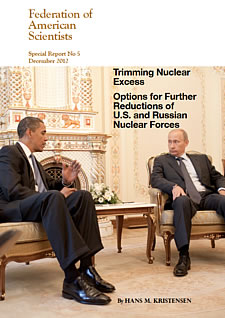
The US and Russian nuclear arms reduction process needs to be revitalized by new treaties and unilateral initiatives to reduce nuclear force levels, a new FAS report argues (click on image to download report).
By Hans M. Kristensen
Despite enormous reductions of their nuclear arsenals since the Cold War, the United States and Russia retain more than 9,100 warheads in their military stockpiles. Another 7,000 retired – but still intact – warheads are awaiting dismantlement, for a total inventory of more than 16,000 nuclear warheads.
This is more than 15 times the size of the total nuclear arsenals of all the seven other nuclear weapon states in the world – combined.
The U.S. and Russian nuclear arsenals are far beyond what is needed for deterrence, with each side’s bloated force level justified only by the other’s excessive force level.
A new FAS report – Trimming Nuclear Excess: Options for Further Reductions of U.S. and Russian Nuclear Forces – describes the status and 10-year projection for U.S. and Russian nuclear forces.
The report concludes that the pace of reducing nuclear forces appears to be slowing compared with the past two decades. Both the United States and Russia appear to be more cautious about reducing further, placing more emphasis on “hedging” and reconstitution of reduced nuclear forces, and both are investing enormous sums of money in modernizing their nuclear forces over the next decade.
Even with the reductions expected over the next decade, the report concludes that the United States and Russia will continue to possess nuclear stockpiles that are many times greater than the rest of the world’s nuclear forces combined.
New initiatives are needed to regain the momentum of the nuclear arms reduction process. The New START Treaty from 2011 was an important but modest step but the two nuclear superpowers must begin negotiations on new treaties to significantly curtail their nuclear forces. Both have expressed an interest in reducing further, but little has happened.
New treaties may be preferable, but reaching agreement on the complex inter-connected issues ranging from nuclear weapons to missile defense and conventional forces may be unlikely to produce results in the short term (not least given the current political climate in the U.S. Congress). While the world waits, the excess nuclear forces levels and outdated planning principles continue to fuel justifications for retaining large force levels and new modernizations in both the United States and Russia.
To break the stalemate and reenergize the arms reductions process, in addition to pursuing treaty-based agreements, the report argues, unilateral steps can and should be taken in the short term to trim the most obvious fat from the nuclear arsenals. The report includes 32 specific recommendations for reducing unnecessary and counterproductive U.S. and Russian nuclear force levels unilaterally and bilaterally.
Full report: Trimming Nuclear Excess
This publication was made possible by a grant from the Ploughshares Fund. The statements made and views expressed are solely the responsibility of the author.

